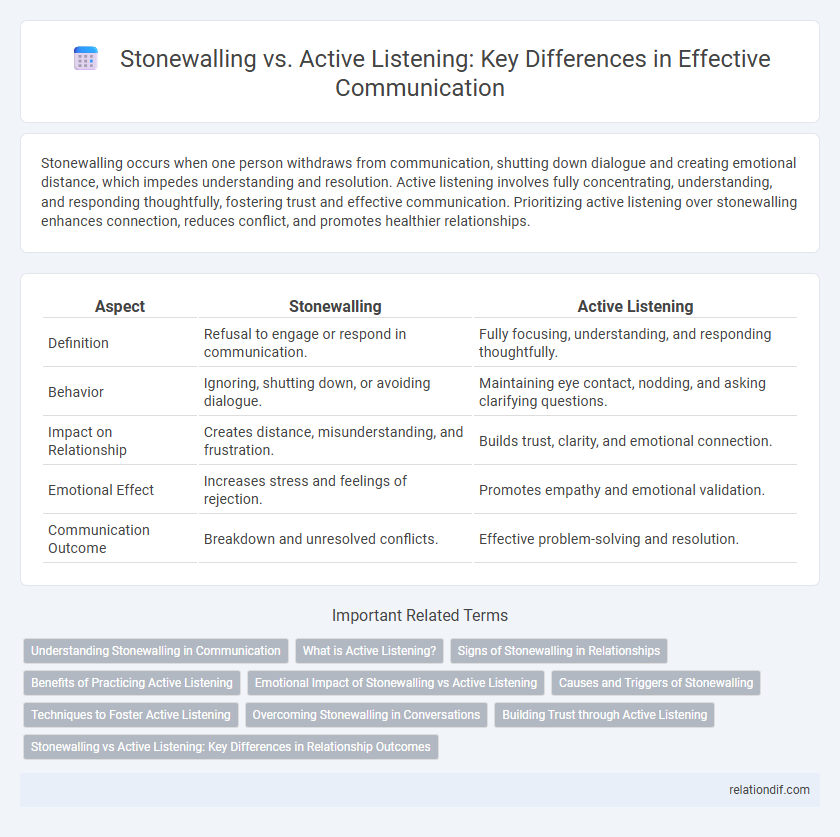Stonewalling occurs when one person withdraws from communication, shutting down dialogue and creating emotional distance, which impedes understanding and resolution. Active listening involves fully concentrating, understanding, and responding thoughtfully, fostering trust and effective communication. Prioritizing active listening over stonewalling enhances connection, reduces conflict, and promotes healthier relationships.
Table of Comparison
| Aspect | Stonewalling | Active Listening |
|---|---|---|
| Definition | Refusal to engage or respond in communication. | Fully focusing, understanding, and responding thoughtfully. |
| Behavior | Ignoring, shutting down, or avoiding dialogue. | Maintaining eye contact, nodding, and asking clarifying questions. |
| Impact on Relationship | Creates distance, misunderstanding, and frustration. | Builds trust, clarity, and emotional connection. |
| Emotional Effect | Increases stress and feelings of rejection. | Promotes empathy and emotional validation. |
| Communication Outcome | Breakdown and unresolved conflicts. | Effective problem-solving and resolution. |
Understanding Stonewalling in Communication
Stonewalling in communication occurs when one party withdraws or refuses to engage, leading to a breakdown in dialogue and increased frustration. This behavior often manifests as silence, evasive responses, or refusal to address issues, hindering conflict resolution and emotional connection. Recognizing stonewalling is crucial for fostering active listening, which involves open, attentive, and empathetic engagement to promote mutual understanding and trust.
What is Active Listening?
Active listening involves fully concentrating, understanding, and responding thoughtfully during communication, promoting empathy and trust. Unlike stonewalling, which is characterized by withdrawing or refusing to engage, active listening encourages open dialogue and emotional connection. This technique enhances conflict resolution and strengthens interpersonal relationships through mindful attention and validation.
Signs of Stonewalling in Relationships
Stonewalling in relationships manifests through consistent avoidance of communication, such as silent treatments, dismissive body language, and refusal to engage in discussions. Signs include emotional withdrawal, delayed or absent responses, and visible frustration or disinterest during conversations. Recognizing these behaviors early helps distinguish stonewalling from active listening, which involves attentiveness, acknowledgment, and empathetic feedback.
Benefits of Practicing Active Listening
Practicing active listening enhances mutual understanding, reduces conflicts, and fosters stronger relationships by ensuring all parties feel heard and valued. It promotes empathy and trust, which are critical for effective communication and problem-solving. Unlike stonewalling, active listening encourages open dialogue and emotional connection, leading to healthier interactions.
Emotional Impact of Stonewalling vs Active Listening
Stonewalling creates emotional distance by shutting down dialogue, often leading to feelings of frustration, rejection, and isolation. Active listening fosters emotional connection, validating feelings and encouraging open expression, which reduces anxiety and builds trust. The contrasting emotional impacts highlight the importance of engagement for healthy, empathetic communication.
Causes and Triggers of Stonewalling
Stonewalling often arises from feelings of being overwhelmed, threatened, or emotionally flooded during a conversation, causing a person to shut down as a defense mechanism. Triggers include intense criticism, perceived attacks, or unresolved conflicts that escalate stress and reduce communication effectiveness. Recognizing these causes helps in addressing stonewalling through strategies like active listening, which fosters empathy and openness.
Techniques to Foster Active Listening
Techniques to foster active listening include maintaining eye contact to demonstrate engagement, providing verbal affirmations such as "I understand" to encourage openness, and reflecting back the speaker's message to confirm comprehension. Avoiding stonewalling behavior, which involves shutting down or refusing to communicate, helps create a safe environment for dialogue. Practicing patience and minimizing distractions further enhances the effectiveness of active listening in communication.
Overcoming Stonewalling in Conversations
Overcoming stonewalling in conversations requires intentionally shifting toward active listening techniques, such as maintaining eye contact, nodding, and paraphrasing the speaker's points to show engagement. Utilizing emotional validation and asking open-ended questions can break down barriers created by silence or withdrawal, promoting openness and trust. Regular practice of empathy and patience fosters a safe environment where both parties feel heard, reducing defensive behaviors and improving communication flow.
Building Trust through Active Listening
Building trust through active listening involves fully concentrating on the speaker, understanding their message, and responding thoughtfully, which fosters open communication and emotional connection. Unlike stonewalling, where one withdraws or blocks communication, active listening demonstrates empathy and respect, encouraging honest dialogue and mutual understanding. Consistent practice of active listening strengthens relationships by creating a safe environment where individuals feel valued and heard.
Stonewalling vs Active Listening: Key Differences in Relationship Outcomes
Stonewalling, characterized by emotional withdrawal and refusal to engage, often deteriorates relationship satisfaction and increases conflict frequency, while active listening promotes empathy, understanding, and resolution by fully attending to the speaker's message. Research highlights that couples practicing active listening experience higher levels of trust and emotional intimacy compared to those exhibiting stonewalling behaviors, which correlate with relationship dissatisfaction and increased risk of separation. Effective communication skills, including active listening, serve as protective factors against the negative outcomes associated with stonewalling.
stonewalling vs active listening Infographic

 relationdif.com
relationdif.com